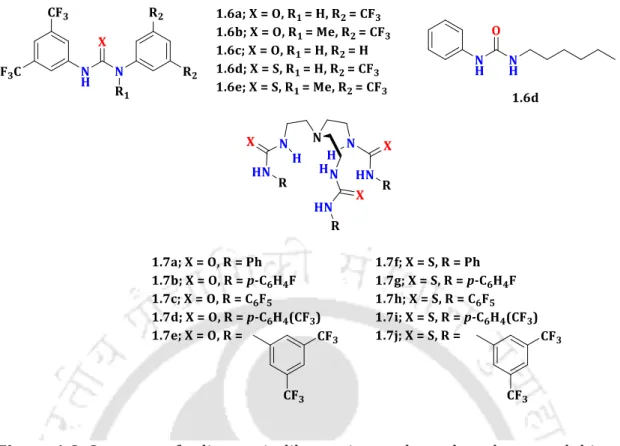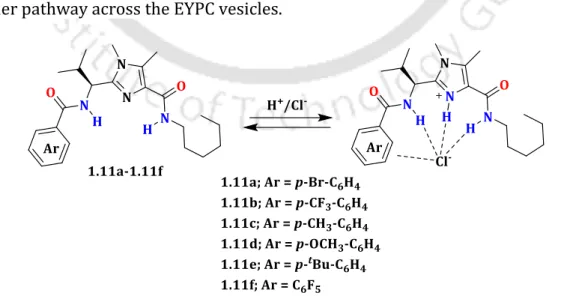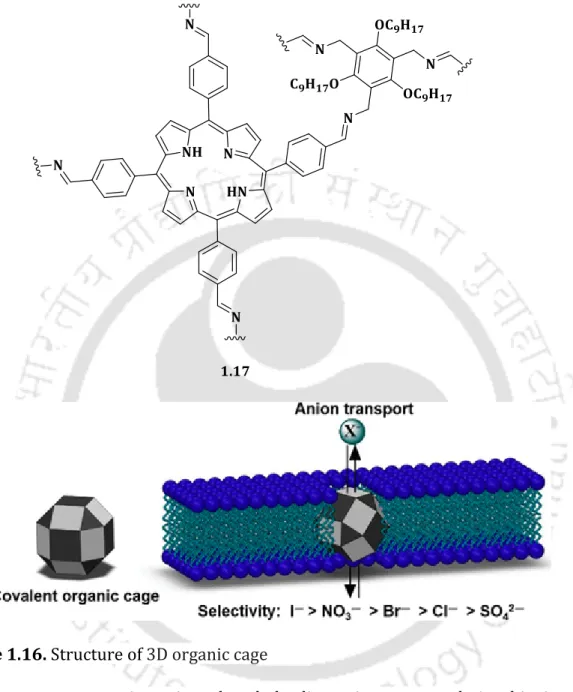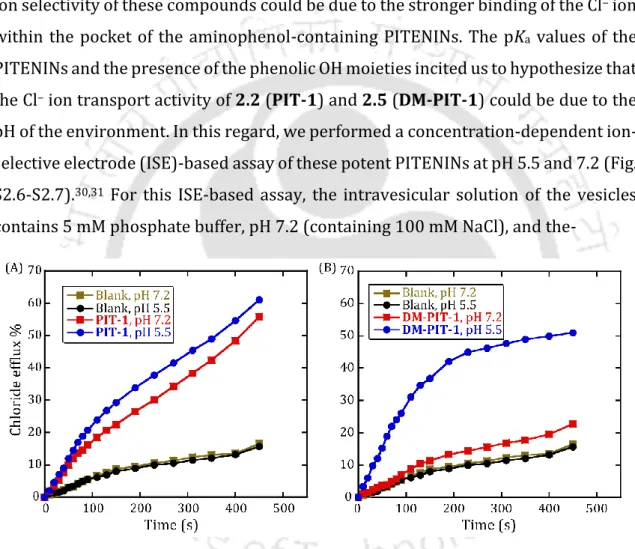This thesis or part of the thesis has not previously been submitted elsewhere for the award of a degree/diploma. This thesis deals with the recognition of the ions, transmembrane transport properties and potential therapeutic applications.
Chapter 1 instantiates the importance of the anionophores in carrying vital functions in cells. It also illustrates the therapeutic implementations of the
The thesis entitled "Using synthetic ion transporters to disrupt ion homeostasis in LUVs and cells" illustrates the biological implications of a variety of synthetic anionophores. The thesis is divided into five chapters based on the experimental results collected throughout the research period.
Introduction
Ion transport across the cell bilayer governs cell proliferation and apoptotic pathways. Furthermore, disruption of ion homeostasis in cancer cells and destruction of the ion gradient can cause cancer cell death.
Chloride Ion Transport by PITENINs Across the Phospholipid Bilayers of Vesicles and Cells
The ion transport properties of 2.2 (PIT-1) and 2.5 (DM-PIT-1) in the presence of FCCP and valinomycin showed that the synthetic transporters are involved in H+/Cl transport. The U-Tube experiment and the cholesterol dependence assay authenticate the carrier-mediated transport behavior of the transporters.

Photoinduced Generation of the Active Chloride/Phosphate Anionophore from its Inactive Proanionophore
To evaluate the photo-triggered cleavage of the proanionophore 3.4 and the in situ generation of the anionophore 3.2 based on 1H NMR. While photo irradiation alone (UV 365 nm, 5 min) without proanionophore 3.4 treatment did not significantly change the viability of HeLa cells.
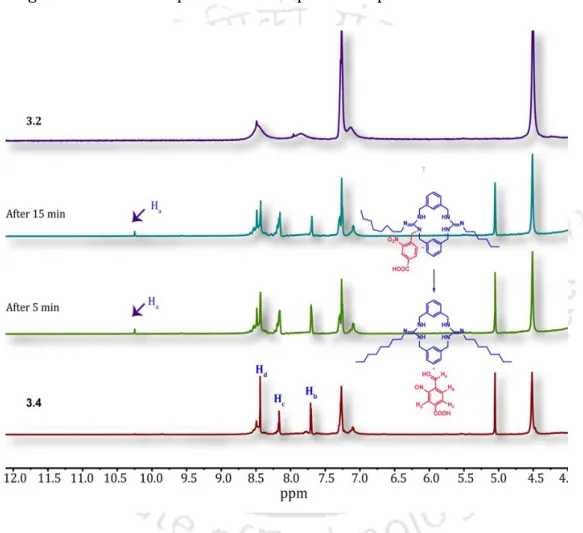
At the same time, the Cl ion transport activity of the regenerated active anionophore 4.2c was closely examined by the Cl-ISE based assay. Cl ion transport activity of the proanionophore under UV irradiation (405 nm) using the HPTS-based fluorescence assay (C).
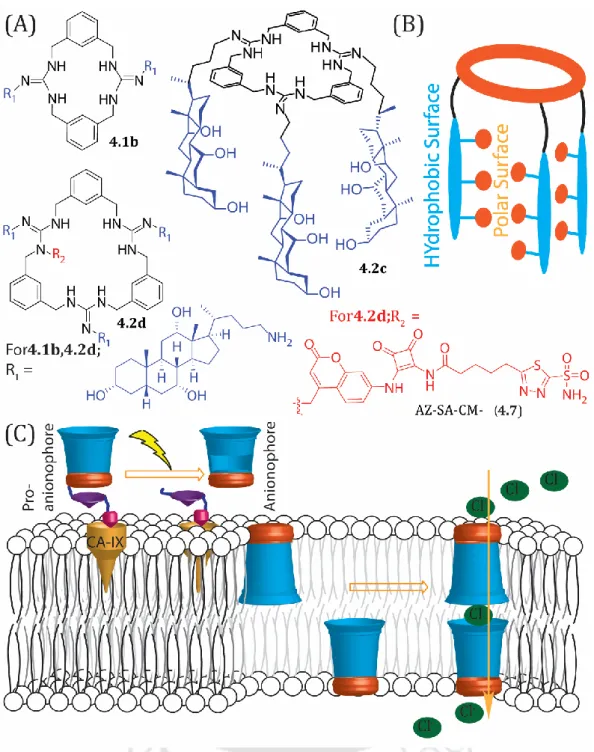
Conclusion
After UV irradiation, the cell viability was seen lowest in the HeLa cells, as the photoproduct contains the acetazolamide derivative, which synergistically causes cancer cell death together with the anionophoric activity of the anionophore 4.2c. Overall, the anionophoric properties of a number of synthetic transporters in the thesis were investigated using well-known experiments, and their biological applications were explored.
- Different modes of transport of the ion transporters
- Therapeutic applications of ion transport
- Artificial anionophores
- Diarylisophthalamide-based anionophores
- Diamidocarbazole-based anionophores
- ortho-phenylenediamine-based anionophores
- trans-decalin-based anionophores
- Anthracene 1,8-bisureas -based anionophores
- Valinomycin-like carriers
- Tren-based urea and thiourea derivatives
- Calixarene-based ion transporters
- Bispidine-based transporters
- Cyclic peptide-based transporters
- Bis-amido imidazole derivatives
- Sulfonamide-based ion transporters
- Triazine-based ion transporters
- Tetraurea macrocycle-based ion transporter
- Fatty acid-based ion transporters
- Organic cage-based ion transporter
- Metal-organic synthetic ion transporters
- Triazole quartet-based anion channel
- Diarylisophthalamide-based ion channels
- Non-toxic anionophores
- Anionophores transporting other ions
- Summary
- Objective of research work
- References
- Background and objective of present work
- Results and discussions
- Design and synthesis of the acylthiourea derivatives
- Anion binding studies of the acylthiourea derivatives
- Chloride ion transport activities of the acylthiourea derivatives
- Relative cation and anion selectivity studies of the acylthiourea derivatives
- Mechanism of chloride ion transport activities of the acylthiourea derivatives
- Pleckstrin Homology Domain Binding Ability of the PITENINs
- Activities of the PITENINs under Cellular Environment
- Summary
- Experiential section 1. Synthesis of compounds
- Synthetic Procedure of the Compounds
- Characterization of the synthesized compounds
- Solution phase anion binding studies 1. 1 H-NMR Titrations
- HPLC analysis of the compounds and stability test for the potent compounds
- References
- Background and objective of present work
- Results and discussions
- Design and synthesis of the guanidine macrocycles
Uniport transporters result in the accumulation of transmembrane potential due to the unilateral motion of the ion. Alteration of calcium concentration in the endoplasmic reticulum can induce a mitochondria-independent apoptotic pathway. A thorough structural analysis of these synthetic anion transporters revealed that the lipophilicity of the compounds plays a crucial role in their Cl-ion transport activities.
First, the Cl- ion recognition abilities of PITENINs were investigated by 1H NMR titration experiments. The PKa values of the PITENINs and the presence of the phenolic OH moieties prompted us to hypothesize that the Cl ion transport activity of 2.2 (PIT-1) and 2.5 (DM-PIT-1) could is due to the pH value of the environment. The interference of the mitochondrial membrane potential (MMP) also suggests the Cl–ion transport efficiency of the compounds (Fig. 2.9).
The pH-dependent measurements showed that the Cl- ion transport property of the PITENINS is switched "ON" slightly below the physiological pH. The normalized fluorescence intensities (FI) at t = 450 s (before addition of Triton X-100 solution) were considered to measure the transport activity of the compounds. The normalized efflux efficiency (EE) values at t = 500 s (just before the addition of Triton X-100 solution) were considered as the transport activity of the compounds.
Here, T0 and T∞ correspond to the transport activity obtained in the absence and in an excess concentration of the compound, respectively.
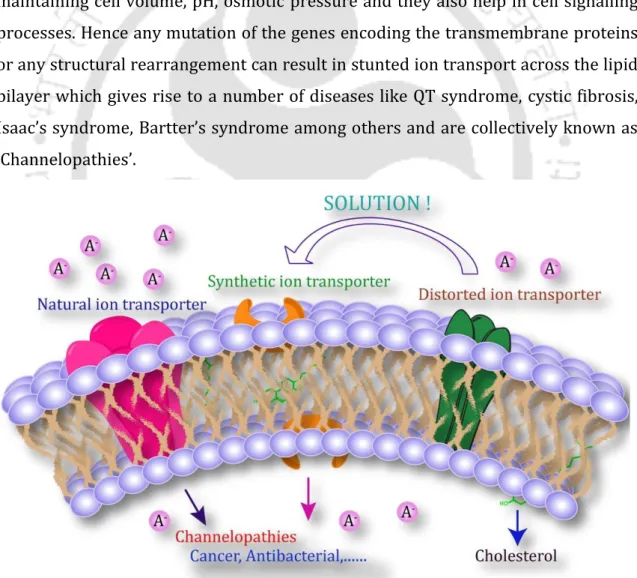
Synthetic routes to the modular anion transporters
Anion binding studies of the guanidine-based macrocycle
The phenomenon of photoinduced generation of the active synthetic transporter was observed fluorometrically and in vitro in the HeLa cell lines. Initially, the thiourea-containing macrocycle was constructed and then the thiourea group was converted to the guanidium groups using desulfurization reaction in the presence of alkylamines of different chain lengths (n = 4, 8 and 10) 5, 6. The logp values of the resulting guanidium macrocycles were calculated using Marvin ketch program and they range within 6.0-12.4 values ensuring their membrane localization propensity.
Better binding with Cl- and phosphate ion may be due to the presence of cyclic guanidium moieties (Fig. S3.1-S3.3). Ion transport activities of guanidine-based macrocyclic derivatives The following were the ion transport properties of guanidium macrocycles.
Ion transport activities of the guanidine-based macrocyclic derivatives Next the ion transport properties of the guanidium macrocycles were
Due to the strong binding, the release of the ion on the other side of the vesicles becomes very difficult. Anion transport properties of compounds (7 µM or 18.48 mol% based on lipids) across EYPC/CHOL-LUVs⊃lucigenin (prepared in 20 mM HEPES buffer containing 225 mM NaCl, pH 7.2) suspended in 20 mM buffer HEPES containing 225 mM NaH 2 PO 4 , pH 7.2.
Mechanism of chloride ion transport activities of the guanidine-based macrocyclic derivatives
By varying the cations (Li+, Na+, K+, Rb+ and Cs+), no significant change in Cl- transport efficiency was observed in either case, indicating that cations (M+) are not involved in the mechanistic pathway (Fig. 3.2B). However, for the transporters that form the channel, increasing the temperature will not create any change in the transport efficiency. In this case, a significant increase in the efficiency of phosphate-mediated Cl- transport of transporter 3.2 was observed, hinting at the transporter-mediated pathway followed by it (Fig. 3.3B).
In both cases, a significant difference in transport efficiency was found, indicating that H+ is not involved in the mechanical process. In the middle of the organic phase, transporter 3.2 was retained to mimic a bilayer trapped by transporter 3.2. Transport mediated by anionophore 3.2 in the U-Tube experiment also demonstrates that the anionophore follows a carrier-mediated pathway.
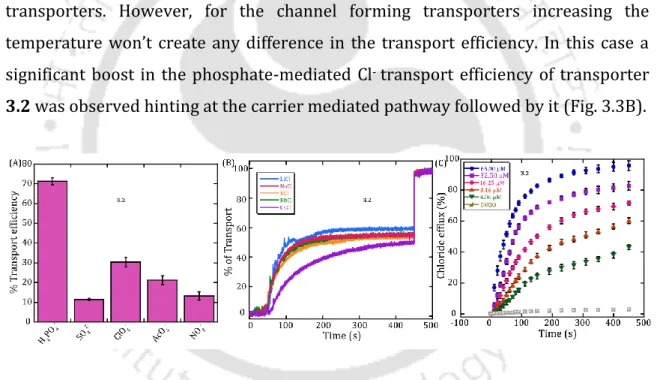
Chloride-mediated phosphate transport by the guanidine macrocyclic anionophore across GUVs
A continuous increase in the blue color of ammonium phosphomolybdate due to the addition of solution from the receiving end clearly depicts the increase in phosphate concentration at the receiving end of the U-Tube mediated by transporter 3.2. Due to the flux of phosphate ions selectively, the fluorescence of the H3Tb complex (initially high) decreases upon addition of the anionophore 3.2 to initiate the kinetics (Fig. S3.9). Fluorescence microscopy images of lucigenin-encapsulated GUVs were recorded at different time intervals after the addition of compound 3.2 (45 μM).
The change in the integrity of GUVs and fluorescence intensity of encapsulated lucigenin was monitored using bright-field and green-field channels, respectively (A–H). Confocal fluorescence microscopy images of lucigenin and Texas Red and GUVs encapsulated with compound 3.2 (45 µM) after addition of compound 3.2 (45 µM). The change in the integrity of the GUVs and the fluorescence intensity of the encapsulated lucigenin were monitored using the red and green field channels, respectively.
Cl-/NaH2PO4 antiport transport of guanidine-based macrocyclic compound across the vesicles using 31P NMR experiment. 31P NMR experiment showed that compound 3.2 (8 µM) is capable of phosphate transport via the Cl─/H2PO4─ antiport pathway.
Molecular dynamics (MD) simulation studies of guanidine-based macrocyclic compound with a model membrane
Regeneration of the active guanidine-based macrocyclic anionophore from proanionophore
Photoinduced release of anionophore 3.2 from proanionophore 3.4 was monitored by 1H NMR titration experiment in DMSO-d6 solvent (A). Biological activity studies of guanidine-based macrocyclic compound It is known that cancer cells require a high concentration of Pi ions inside them.
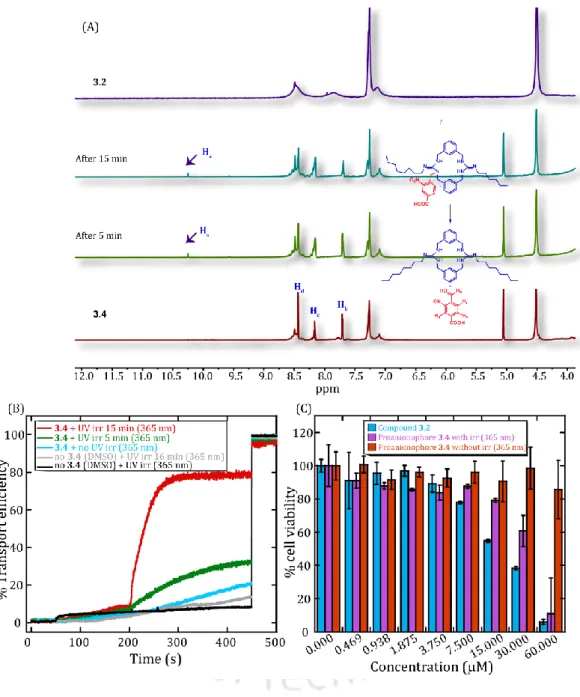
Summary
Experiential section
- Synthesis of guanidine-based macrocyclic compounds 1. General information
- Binding studies of guanidine-based macrocyclic compounds 1 Spectrophotometric titration studies
- Lucigenin fluorescence quenching measurements of guanidine-based macrocyclic compounds in the presence of different anions
- Ion transport activity studies of guanidine-based macrocyclic compounds
- Measurement of half-maximal effective concentrations (EC 50 ) of the compounds for different anions
- Lucigenin-based selectivity studies
- Ion transport activity studies using the ion-selective electrode-based assay
- U-tube assay
- Evidence of mechanistic pathway of transport of the anionophore 1. Temperature-dependent DPPC assay
- Evaluation of transport of phosphate using Tb(III) fluorescent chemosensor 16
- Direct evidence for phosphate transport by 31 P NMR measurements The EYPC/CHOL-LUVs were prepared according to the method described in the
- Molecular dynamics (MD) simulation studies
- Regeneration of the active anionophore from proanionophore
After maximum consumption of the starting material, the solution was filtered and the filtrate was collected and concentrated under reduced pressure. In a dry and clean glass vial, 3940 µL of buffer solution (20 mM HEPES buffer containing 225 mM NaH2PO4, pH 7.2) and 50 µL of the EYPC/CHOL-LUV were taken, and the glass electrode was immersed in the solution under mild stirring condition. The formation of the blue colored solution shows the phosphate transport from the right arm to the left arm.
Representative images of a U-tube colorimetric assay using ammonium molybdate in the presence and absence of 3.2 (1 mM) to detect phosphate ion transport. Kinetics were initiated by adding 10 µL of the compound of interest in DMSO solution to the cuvette at t = 50 s. 10 µL of Texas Red-PE was added to 100 µL of GUV solution and the solution was mixed thoroughly.
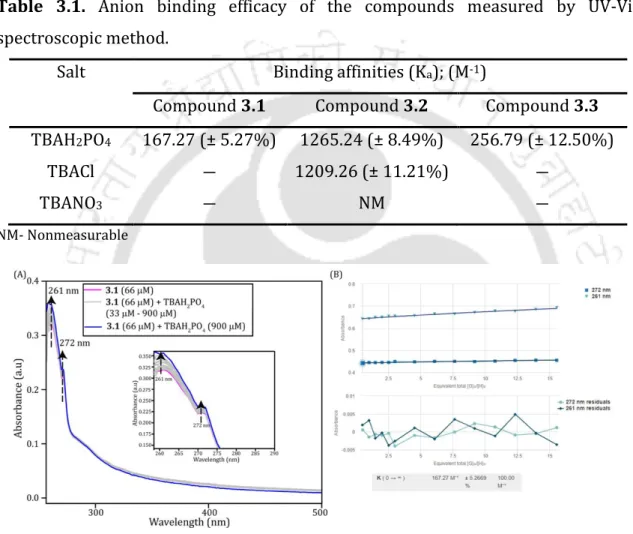
Results and discussions
- Design and synthesis of the synthetic ionophore derivatives
Acetazolamide is a known inhibitor of carbonic anhydrase-IX (CA-IX), which is overexpressed in some cancer cells. CA-IX has been reported to help cancer cells adapt to microenvironmental conditions such as hypoxia, nutrient deprivation, mild acidity among others. be used to effectively achieve the death of cancer cells.5. However, in this case light irradiation disrupts channel formation and hence ion transport giving control over switching off ion transport properties whereas the opposite would have been more beneficial.
It is made by using the 7-aminocoumarin group in the photolabile group which exhibits long-wavelength absorption properties and good photolysis efficiency. It was predicted that the guanidine-based macrocycle would help recognize and bind the Cl- ion and the hydroxyl groups of the cholic amine moiety would help facilitate the transport process across the lipid bilayer. The engineered proanionophore facilitates targeted delivery of the proanionophore specifically to cancer cells and subsequent photo-induced discharge of the anionophore.
Synthetic route to the macrocyclic anion transporters
- Anion binding studies of the synthetic ionophore derivatives
- Chloride ion transport activities of the synthetic ionophore derivatives Nextly the ion transport properties of the anionophores were tested initially in
- Relative cation and anion selectivity studies of the synthetic ionophore derivatives
- Mechanism of chloride ion transport activities of the synthetic ionophore derivatives
- Regeneration of the active anionophore from proanionophore
- Activities of the synthetic ionophore under Cellular Environment
- Summary
- Experimental Procedures 1. General information
- Synthesis and characterization of compounds
Effect of the concentration of cholesterol in the EYPC/CHOL membrane on the Cl ion transport properties of aninophore 4.2c (D). In this experiment, the cholesterol concentration in the preparation of the vesicles was varied and the resulting effect on the transport activity of chloride ions was observed. From these experiments, the regeneration of the active anionophore and the photoproduct could be distinguished (Fig. 4.3).
In the HeLa cell line however under similar conditions, toxicity was seen from 15 μM concentration of proanionophore 4.2d. The blot showed an inverse relationship of proanionopore concentration to procaspase 9 concentration. After maximal consumption of starting materials monitored by TLC, the solution was concentrated under reduced pressure.
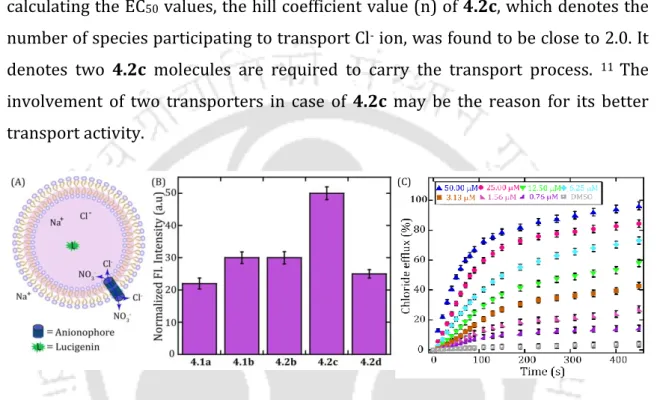
Synthetic routes of the photo-linker of 4.7
Synthesis of compound 4.2d
A 5 mL 3M HCl solution was added to the mixture and the product was extracted three times using EtOAc solution (3*20 mL). The pure brown product was purified via column chromatography using MeOH/DCM (0-30%) as the eluent system.
UV-Vis Titrations
Ion transport activity studies
- HPTS-based selectivity studies 1. Anion selectivity studies
- Ion transport activity studies using the ion-selective electrode-based assay
- Evidence for mobile carrier mechanism
- Regeneration studies using proanionophore
EYPC-LUVs lucigenin using NaNO3 as intravesicular solution was prepared according to the protocol previously mentioned in section 3.4.4.1. Liposomes were prepared for performing HPTS-based anion selectivity experiments as mentioned according to the procedure in section 3.4.4.1 involving HPTS dye. Liposomes were prepared for performing cation selectivity experiments based on HPTS as mentioned according to the procedure in section 3.4.4.1.
The Cl─ ion efflux efficiency of the compounds was assessed according to the procedure mentioned in 2.4.4.4.4. The EYPC/CHOL-LUVs for the cholesterol dependence experiment with ISE were prepared according to the procedure mentioned in Section 2.4.4.4.2. The ion transport with these LUVs was performed according to the procedure mentioned in section 2.4.4.4.3.


